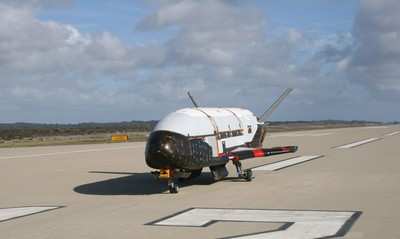X-37B Prototype Still In Search Of A Mission, Science Group Says
There has been another delay in the scheduled launch of the third X-37B space plane mission, according to the United Launch Alliance website. The U.S. Air Force had scheduled the launch from Cape Canaveral on November 27th, but ULA now reports that "The new planning date for the launch of an Atlas V carrying the third X-37B Orbital Test Vehicle (OTV-3) payload for the U.S. Air Force is Dec. 11, 2012, pending approval from the range."

And while the mission has been delayed multiple times, a group of scientists continues to question the need for the spacecraft. According to the Union of Concerned Scientists (UCS), the plane could carry out a range of missions, but in each case there are better, more efficient, and more cost-effective ways of accomplishing them. And because it is an Air Force project and its details are classified, the plane has generated confusion, speculation and, in some cases, concern about its actual purpose.
In April 2010, the Air Force launched the first of two prototype space planes, which stayed in orbit for seven months. In March 2011, it launched the second prototype, which remained in orbit for more than a year. This launch will mark the first prototype’s return to space.
What distinguishes the space plane from other spacecraft is its ability to return from orbit and land on a runway. This capability requires extra structure, such as wings, landing gear and heat shielding to withstand the rigors of re-entry, making it significantly heavier than comparable spacecraft that are not designed to return to Earth. Because of this extra mass, the space plane is more difficult to maneuver in space and significantly more expensive to launch. According to a new UCS briefing paper, other spacecraft can carry payloads into orbit, maneuver in space, rendezvous with satellites, release multiple payloads, and return to Earth for tens of millions of dollars less than the space plane.

“The ability to return to Earth carries a high price,” said Laura Grego, a senior scientist with UCS’s Global Security Program, in a news release. “Most space missions don’t require bringing a spacecraft back to Earth, and the space plane makes no sense for them. And if returning to Earth does make sense, spacecraft usually use parachutes, not wings and landing gear. Compared with those, the space plane will have a harder time carrying payloads into orbit, maneuvering in space, rendezvousing with satellites, and releasing multiple payloads.”
The Air Force has stated that the X-37B will allow it to carry out experiments in space over a long period of time and return them to Earth. Thus far, however, the Air Force has not provided any cost or capability analyses that compare the space plane with simpler spacecraft that return by parachuting to Earth rather than landing on a runway.
Given the Air Force’s reticence in discussing the rationale behind the space plane and the fact that it is a military program, other countries may infer that the X-37B has a specialized military purpose. But, according to Grego, the space plane does not make sense as a space weapon or a vehicle for deploying space weapons.
“In a time of tightening budgets,” said Grego, “the administration and Congress should take a close look at the X-37B program and be figure out why they’re spending money on a program that has no persuasive rationale.”
 ANN's Daily Aero-Linx (04.16.24)
ANN's Daily Aero-Linx (04.16.24) Aero-News: Quote of the Day (04.16.24)
Aero-News: Quote of the Day (04.16.24) Airborne 04.10.24: SnF24!, A50 Heritage Reveal, HeliCycle!, Montaer MC-01
Airborne 04.10.24: SnF24!, A50 Heritage Reveal, HeliCycle!, Montaer MC-01 Airborne 04.12.24: SnF24!, G100UL Is Here, Holy Micro, Plane Tags
Airborne 04.12.24: SnF24!, G100UL Is Here, Holy Micro, Plane Tags Airborne-Flight Training 04.17.24: Feds Need Controllers, Spirit Delay, Redbird
Airborne-Flight Training 04.17.24: Feds Need Controllers, Spirit Delay, Redbird




